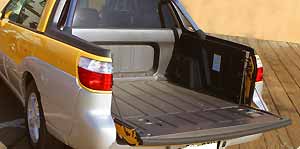2003 Subaru Baja Program #2206
When we were first introduced to the new Subaru Baja, Subaru officials were quick to point out that the Baja was more than a car, but that it wasn’t a truck. It’s not a wagon either, they said, and don’t even think about calling it an SUV! “So, what do you call it?,” we asked. But instead of answering our question, they just handed us the keys and told us to “go outside and play.”
So we did! And the more we played, the more we found the 2003 Subaru Baja to be a genuine “crossover” vehicle. More than just marketing hype, the Baja is a clever cross between a car, an SUV, and a pickup truck.
But those familiar with Subaru history know that the Baja is not a completely new concept. It was back in 1978 that Americans were introduced to a little vehicle bearing the cumbersome moniker, “Bi-Drive Recreational All-Terrain Transporter,” or Brat! After a 10-year run, the Brat was sent to the corner for a permanent time out. But Subaru revisited the open bed theme at the 2000 Los Angeles Auto Show with the ST-X Concept, and it was this dream in sheet metal that became the new production Baja. Made possible as both the ST-X and the Baja are based on the current Legacy/Outback sedan/wagon platform, and share the same 104.3 inch wheelbase. But we’re still impressed at how well the best features of the show car transferred to reality.
The most obvious one is, of course, the tough, fully lined, 41.5 inch cargo bed, which Subaru thinks is just the right size for handling a weekend’s worth of toys. Lower the tailgate and flip over the optional bed extender and the toy box grows to 60.5 inches. You can also flip down the license plate holder to keep the plate visible when the tailgate is lowered.
 But unlike the ST-X Concept, and for that matter the somewhat similar, but much larger, Chevrolet Avalanche, you can’t open the Baja’s cabin to extend the entire cargo bay. You can handle long items with what Subaru calls the Switchback System. Switchback consists of a 31- inch wide, 12-inch tall pass through door that hides behind a flip and fold rear seat. Once open, it lengthens the load floor to a very useful 75 inches. Still, we wish Switchback was larger.
But unlike the ST-X Concept, and for that matter the somewhat similar, but much larger, Chevrolet Avalanche, you can’t open the Baja’s cabin to extend the entire cargo bay. You can handle long items with what Subaru calls the Switchback System. Switchback consists of a 31- inch wide, 12-inch tall pass through door that hides behind a flip and fold rear seat. Once open, it lengthens the load floor to a very useful 75 inches. Still, we wish Switchback was larger.
Since Baja owes much to the Outback, it includes Subaru’s proven and reliable full-time all-wheel drive systems. The optional 4-speed automatic transmission mates with an Active All- Wheel Drive system. It distributes power front to rear through an electronically managed continuously variable transfer clutch. With the standard 5-speed manual, the Baja sports a 50/50 split Continuous All-Wheel Drive system which moves power around via a viscous-coupling center differential. Both setups also incorporate a viscous limited-slip rear differential for added security.
To further accommodate your off-road adventures, the Baja uses a compliant, fully independent, long-travel suspension with struts up front and a multi-link design at the rear. Riding on standard 16 inch rims and rubber, the Baja has a respectable 7.3 inches of ground clearance. In addition to a very comfortable on and off-road ride, this suspension also gives the Baja some serious agility. Side to side transitions were smooth and controlled, and the all-wheel drive system and tires provided plenty of grip, keeping the Baja firmly planted throughout our exercise.
Under the Baja’s hood you’ll find a familiar 2.5 liter, single-cam, flat-4 engine which spins out 165 horsepower and 166 pound-feet of torque. Neither of which comes on strong until fairly high in the rev band. Which means you really have to thrash the Baja off the line to gain momentum. Our 5- speed Baja loafed to 60 in 10 seconds, and through the quarter mile in 17.3 seconds at 79 mph. The Outback’s 3.0-liter 6 would be welcomed.
For brakes, the Baja uses the Outback’s 4-wheel disc, 4-channel ABS system. We averaged 133 feet from 60, with little fade or locking.
Inside the Baja’s almost luxurious 4-passenger interior, you’ll find that most of the controls and amenities have also been lifted from the Outback. The bucket seats add standard perforated leather center inserts with Baja logos. The gauges are trimmed with chrome rings and there’s a sprinkling of bright trim for a sporty look. A/C and an 80-watt CD audio system are also standard.
When it comes to pricing, the well-equipped Baja, with the manual, starts at a slightly stiff $24,520. Choose the automatic and you’ll pay $25,320.
Price and size-wise, the Baja falls in between big crossovers like the Avalanche, and compact efforts like the Toyota Matrix. And although in XRS trim the Matrix offers more street performance, it’s not nearly as versatile. And for many, the Avalanche is way more crossover than they’ll ever need. Which brings us back to Subaru’s claim that when it comes to crossovers, the 2003 Subaru Baja is just right. And we’re inclined to agree!
Specifications
- Engine: 2.5 Liter, Single-cam, Flat-4
- Horsepower: 165
- Torque: 166 Lb Feet
- 0-60 MPH: 10.0 Seconds
- 1/4 Mile: 17.3 Seconds @ 79 MPH
- 60-0 MPH: 133 Feet
- EPA Mileage: 20 MPG City 25 MPG Highway






